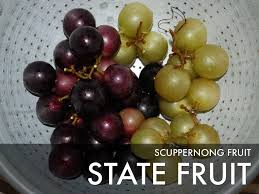It’s almost scuppernong season and I’m looking forward to picking some grapes.
For the last couple of years, I was unable to pick at Lake Apshawa Farm & Nursery, the Clermont vinery where I usually gather my annual supply of scuppernong grapes. This year, I’m eager to revisit one of my favorite local sources of organically grown fruit during the month-long U-pick season that begins August 1st and continues through the first week in September.
 |
| Amber picking muscadine grapes at Lake Apshawa Farm & Nursery in 2006 |
For those who have never tried them, scuppernong is a uniquely southern crop, a type of light-colored muscadine grape native to Southeast U.S. The indigenous fruit was first noted in the 1500s by New World explorers who described in their logs a ‘white grape’ growing wild along coastal river valleys in what later was to become North Carolina.
 |
| Fruit of the vine |
A century passed before evidence of the grape’s cultivation appeared in the log of another explorer traveling along Scuppernong Lake in North Carolina. The fruit’s association with that body of water stuck. Ever since, the large, round, seeded bronze-skinned grape has been known as a scuppernong and in 2001 it officially became the North Carolina state fruit.
 |
Side-by-side
Dark-skinned muscadine and light-skinned scuppernong grapes |
North Carolina may be where explorers first discovered wild scuppernong vines but Florida is the birthplace of American wine dating back to French Huguenot settlements during the 16th Century in northeastern coastal parts of the state where wild muscadine grapes grew prolifically.
Making wine from muscadine grapes continues to be an important part of Florida agriculture. There are currently 24 certified wineries in the state and while I prefer eating my scuppernongs fresh by the bowlful, many people enjoy the fruit of the vine by the glassful. It is also well suited for jams, jelly and juice.
No matter how they’re used, scuppernong grapes are an easy fruit to gather. Because they are commercially grown on vines trained to trellises – wires stretched horizontally between upright posts – picking requires very little bending. The fruit grow in clusters enabling a picker to gather several grapes in one spot before moving on to the next bunch of golden orbs peeking out from behind lush green lobed leaves. In less than a half-hour, it’s possible to collect enough grapes to snack on for several days.
Although the grapes may be an inexpensive treat that’s easy to gather, finding a nearby U-pick vineyard can be a challenge. In addition to Lake Apshawa Farm & Nursery in Clermont, I’m only aware of one other Lake County farm that welcomes U-pickers,
Heather Oaks Farm in Lady Lake.
Both locations produce a selection of white and red wines made from dark-skinned muscadine grapes and light-skinned scuppernongs. Lakeridge also sells a wonderful non-alcoholic juice made from freshly pressed scuppernong grapes. Just mentioning it makes my mouth water.
This year, Tommy Free, owner of Lake Apshawa Farm & Nursery tells me he has several new varieties of both muscadine and scuppernong grapes ready to pick. “It looks like a productive year at the vineyard,” Free said.
I for one am excited to sample both old and new varieties of one of my favorite local fruits.
If you plan to visit one of the local U-pick grape farms or wineries, call first for information on availability, location, price and hours of operation.
Lake Apshawa Farm & Nursery: 18030 W. Apshawa Rd., Clermont; 352-394-3313
Heather Oaks Farm: 4240 Christmas Lane, Lady Lake; 352-753-1184;
www.heatheroaksfarm.com
Lakeridge Winery & Vineyard: 19239 U.S. 27 North, Clermont; 1-800-768-WINE;
www.lakeridgewinery.com
Oak Haven Farm & Winery: 32418 Avington Road (formerly Bird Road), Sorrento; 352- 735-1996, 352-516-2139;
www.berriesandwines.com
Read my 2009 story about scuppernong grapes



















































